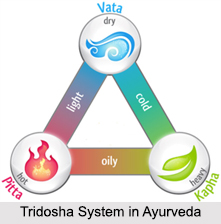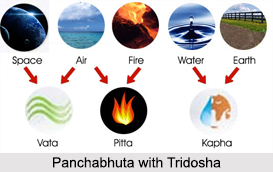 Tridosha System in Ayurveda demonstrates the life cycle of an individual. According to Ashtanga Ayurveda, the body is constituted of five elements or Panch Mahabhutas - space, air, fire, water and earth. These elements give rise to the three bodily humours or the Tridoshas -
Tridosha System in Ayurveda demonstrates the life cycle of an individual. According to Ashtanga Ayurveda, the body is constituted of five elements or Panch Mahabhutas - space, air, fire, water and earth. These elements give rise to the three bodily humours or the Tridoshas -
•Vata
•Pitta
•Kapha
These three govern all physical and mental functions of the body. To maintain good health and vitality and to protect the body from foreign invasions, a balance of the three doshas is a vital necessity.
Amalgamation of Panch Mahabhutas with Tridosha
Each dosha is a combination of any two of the five elements of Panch Mahabhutas with the predominance of one. Since these three doshas are responsible for all the physiological and the psychological processes within the body and mind, they can explain every physical activity, characteristic, mental capacity, physical energy, thoughts and the emotional tendency of human beings.
 While the space and air together forms the "Vata" personality, it is the combination of fire and water that forms the "Pitta" constitution and the unification of water and earth therefore forms the "Kapha" constitution. These actually govern the physio-biological changes and also mark the physio-pathological changes in the body. Therefore when the three doshas are balanced body remains healthy. According to Charaka, the great Ayurvedic sage: “Vata, pitta and kapha maintain the integrity of the living human organism in their normal state and combine so as to make the man a complete being with sense organs possessing strength, good complexion and assured of longevity of lifeâ€.
While the space and air together forms the "Vata" personality, it is the combination of fire and water that forms the "Pitta" constitution and the unification of water and earth therefore forms the "Kapha" constitution. These actually govern the physio-biological changes and also mark the physio-pathological changes in the body. Therefore when the three doshas are balanced body remains healthy. According to Charaka, the great Ayurvedic sage: “Vata, pitta and kapha maintain the integrity of the living human organism in their normal state and combine so as to make the man a complete being with sense organs possessing strength, good complexion and assured of longevity of lifeâ€.
Role of Tridosha in Ayurveda
Doshas exist in every cell, tissue and organ. The interplay of the Tridosha determines the conditions of health and characteristic attributes of a person. A perfect balance of these rewards health and positive growth. When the body suffers from an imbalance within the three doshas, disease is caused.
Vata controls mobility and is embodied by the nervous system. Pitta is the principle of bio-transformation and the generator of the whole metabolic process in the body. Kapha is associated with cohesion and channelization of body-fluids.
The variation in permutations and combinations of these doshas and different ruling qualities (Gunas) create a unique "Prakriti" or nature or physiological structure for every human. This distinguishes one man from another.
These three doshas are interrelated and interdependent and changing constantly in this ever-changing universe. The disruption in the activities of one dosha affects the other, and if not taken care properly, the body begins to degenerate and needs proper medical care. Balance of the three doshas produces a healthy body and a healthy mind and eventually makes a well-balanced human being.
Sama Dosha
Sama Dosha is occurred when the three humours are in equilibrium and the soul is clean and in accordance with the mind. Doshas play a vital role in the basic foundation of Ayurveda. They are responsible for synchronizing and maintaining all the substances and structures of the body, leading to the physical condition of Sama Dosha.





